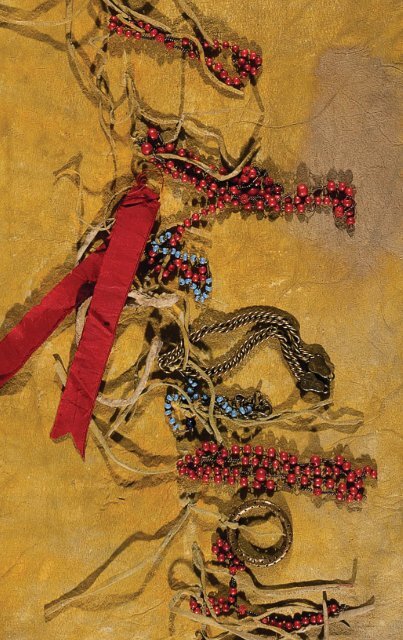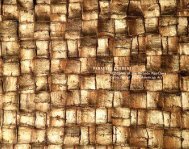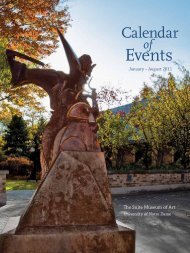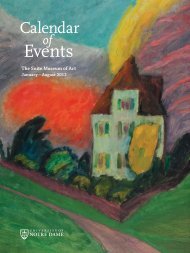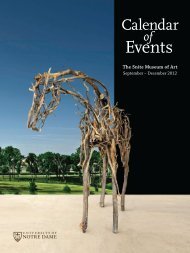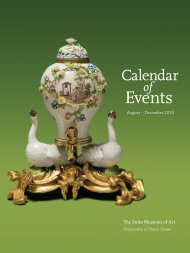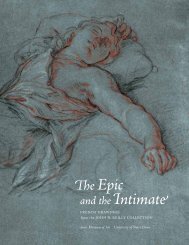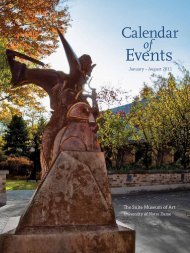HISTORY INTO ART AND ANTHROPOLOGY - Snite Museum of Art ...
HISTORY INTO ART AND ANTHROPOLOGY - Snite Museum of Art ...
HISTORY INTO ART AND ANTHROPOLOGY - Snite Museum of Art ...
Create successful ePaper yourself
Turn your PDF publications into a flip-book with our unique Google optimized e-Paper software.
PREFACE<br />
JOANNE M. MACK<br />
For Father Eli Washington John Lindesmith, his extensive collection <strong>of</strong> disparate<br />
artifacts represented a visual record <strong>of</strong> everyday life in the American West and in<br />
his native state <strong>of</strong> Ohio from the mid-1800s to the early 1900s that could be shared<br />
with the public and used for educational purposes. Because he maintained detailed<br />
records concerning the acquisition <strong>of</strong> each item as well as its historical and cultural<br />
context, the collection also is anthropologically significant. In addition, many <strong>of</strong><br />
the objects in the collection are beautifully made, so they can be appreciated for<br />
their artistic merit. Although Lindesmith gathered and preserved a wide variety <strong>of</strong><br />
items, the present exhibition and accompanying catalogue focus on fine beadwork,<br />
weaving, and painting by Native Americans—primarily the Northern Cheyenne.<br />
Father Lindesmith built most <strong>of</strong> his collection during a period <strong>of</strong> enormous<br />
upheaval and transition for the people <strong>of</strong> the Northern Plains, Native American<br />
and Euro-American alike. The so-called Indian wars were coming to an end, and<br />
Native Americans were being forced to live on reservations and adopt Euro-<br />
American cultural practices while abandoning their own. The Battle <strong>of</strong> the Little<br />
Big Horn was fought in 1876, just four years before Lindesmith arrived at Fort<br />
Keogh in the Montana Territory, and the Massacre <strong>of</strong> Wounded Knee occurred<br />
in 1890, shortly before he retired from the U.S. Army and left the military installation.<br />
Around the same time, Euro-Americans were changing the face <strong>of</strong> the West,<br />
building towns and cities, some <strong>of</strong> which grew and exist today and others that<br />
have all but disappeared. Trappers and explorers gave way to families who came<br />
west to homestead.<br />
In 1880, when Father Lindesmith arrived in the Montana Territory, there were so<br />
few ministers and priests that he was asked to perform baptisms, weddings, and<br />
funerals for both Catholics and non-Catholics in the area surrounding the fort. 1<br />
When he left in 1891, to return to Ohio, churches were being built and staffed by<br />
ministers and priests. Ursuline nuns established schools on the Crow and Cheyenne<br />
reservations during Lindesmith’s early days at Fort Keogh, and by the time <strong>of</strong> his<br />
departure—two years after the territory became a state—there also were schools<br />
for Euro-American children not only at Fort Keogh and in Miles City but also in<br />
towns across Montana.<br />
20 21


